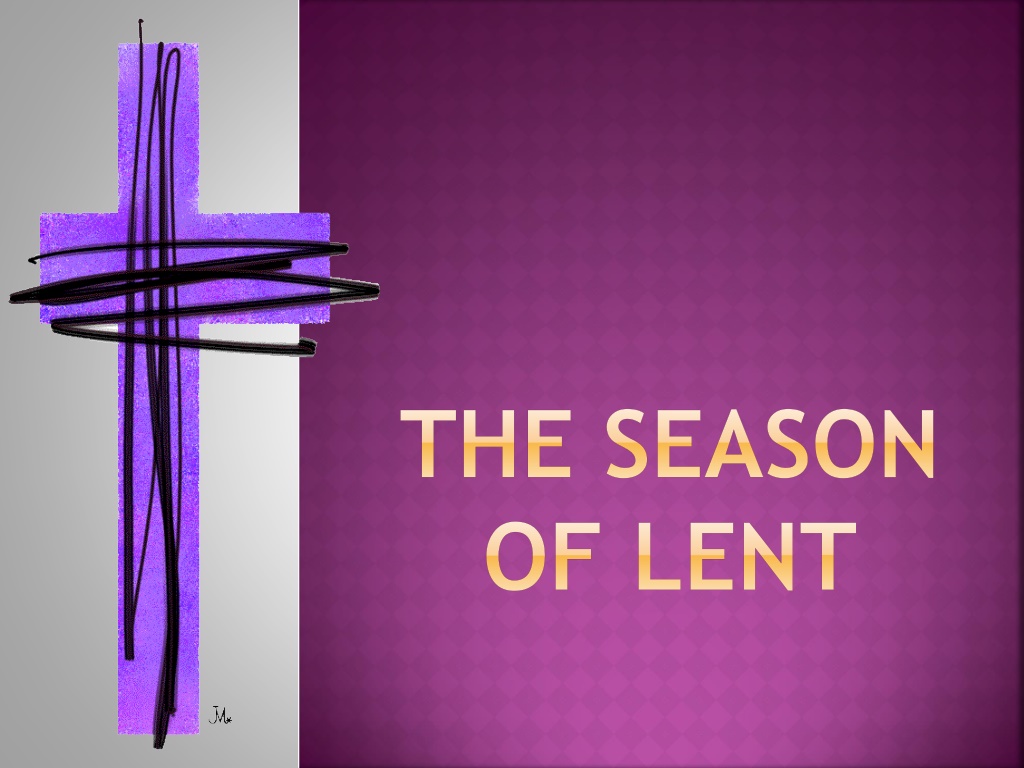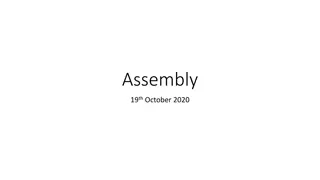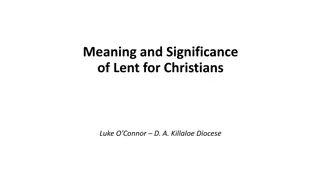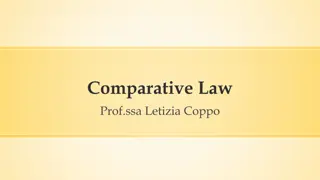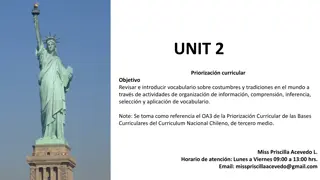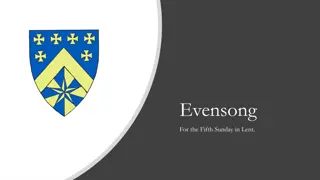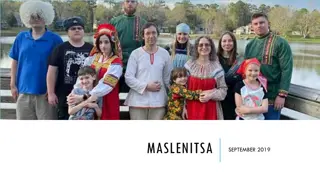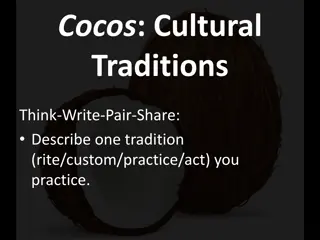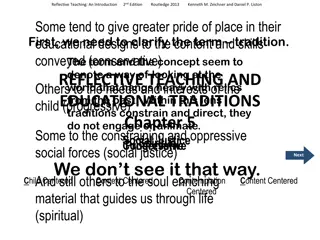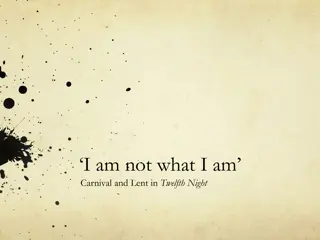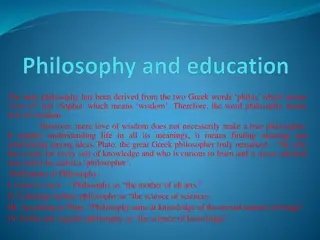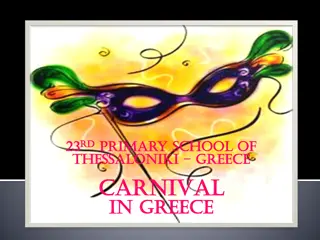Understanding the Meaning and Traditions of Lent
Lent is a sacred season observed by Christians, historically rooted in prayer, fasting, and alms-giving. Over the centuries, Lent has evolved, with Vatican II emphasizing its baptismal character and call to conversion. Learn about the pillars of Lent and dispel common misconceptions about this period of spiritual reflection and preparation.
Download Presentation

Please find below an Image/Link to download the presentation.
The content on the website is provided AS IS for your information and personal use only. It may not be sold, licensed, or shared on other websites without obtaining consent from the author. Download presentation by click this link. If you encounter any issues during the download, it is possible that the publisher has removed the file from their server.
E N D
Presentation Transcript
THE SEASON OF LENT
The Direction of Intention My God, give me the grace to perform this action with you and through love for you. In advance, I offer to you all the good that I will do and accept all the difficulty I may meet therein. Our Lady of Good Counsel, Pray for us. St. Francis de Sales, Pray for us
WHAT LENT IS NOT. A 40 day wake for Jesus. A season for beating yourself up because God wants you to feel like a worthless worm. A season for everyday self-improvement projects in the guise of Lenten discipline. A season for one-upping other Christians who either don't observe it or who observe it in different ways according to their traditions. A season for earning extra-credit points with God.
WHAT LENT WAS . First 3 centuries . 3 days of preparation for the celebration of Easter Prayer, Fasting, Alms-giving, an all night Vigil Some places A Week Beginnings of Holy Week Commemorations of Resurrection(Baptism), Passion and Burial, The Lord s Supper End of 3rdCentury ROME Extended to three weeks Became a time of intense preparation for catechumens 4thCentury Christianity legalized Adoption of 40 Day period of training for catechumens and the Baptized as a preparation for Baptism and Renewal of baptismal promises Middle Ages to Vatican II Once most were baptized, Fasting and Repentance became dominant themes Lent lost its baptismal character.
WHAT LENT IS. Lent since Vatican II Vatican II called for a renewal of Lent- recover its ancient baptismal character Catechumenate restored with the Rite of Christian Initiation of Adults (RCIA) Turn away from sin and be faithful to the Gospel. - Recalls our baptismal promises to reject sin and profess our faith IT IS A CALL TO CONVERSION! We walk with the Catechumenate so that we will be prepared to renew our baptismal promises when Easter arrives.
WHAT LENT IS. What are the three Pillars of Lent? Prayer, Fasting and Alms-giving (Works of Charity) Fasting Fasting without changing our behavior is meaningless: This, rather, is the fasting I wish: release those bound unjustly, untying the thongs of the yoke; setting free the oppressed, breaking every yoke; sharing your bread with the hungry, sheltering the oppressed and the homeless; clothing the naked when you see them, and not turning your back on your own. (Is 58:6-7)
WHAT LENT IS. Prayer More prayer should draw us closer to the Lord Pray for the grace to live out our baptismal promises more fully Allows us to be open to God s direction in our life Alms giving Works of Charity Sign of our care for those in need It should involve more than just giving money Expression of gratitude for all that we have been given Works of charity and promotion of justice are integral elements of the Christian way of life begun at Baptism. http://2.bp.blogspot.com/_blMH8OhgwZQ/SaN6fDY0g3I/AAAAAAAABO4/jQrLEiZ6apI/s400/iStock_000003420105XSmall.jpg
ALL YOU WANTED TO KNOW ABOUT LENT BUT WE AFRAID TO ASK! When does LENT begin and end? Lent begins on Ash Wednesday and concludes prior to the Commemoration of the Lord s Supper on Holy Thursday Pascal Triduum along with Pascal Fast begins on Holy Thursday through the beginning of the Great Easter Vigil on Holy Saturday. The Sunday s of Lent are not part of the discipline of Lent since Sunday celebrates the Resurrection Where did Ash Wednesday come from? Following the 4thcentury, as the penitential nature of Lent is stressed .it became associated with the 40 days Christ spent in the desert (Gospel for first Sunday of Lent). Ash Wednesday is 40 prior to Easter Sunday.
ALL YOU WANTED TO KNOW ABOUT LENT BUT WE AFRAID TO ASK! Lent since Vatican II Vatican II called for a renewal of Lent- recover its ancient baptismal character Catechumenate restored with the Rite of Christian Initiation of Adults (RCIA) Turn away from sin and be faithful to the Gospel. - Recalls our baptismal promises to reject sin and profess our faith IT IS A CALL TO CONTINUED CONVERSION! We must walk with the Catechumenate so that we will be prepared to renew our baptismal promises when Easter arrives.
ALL YOU WANTED TO KNOW ABOUT LENT BUT WE AFRAID TO ASK! Why Ashes? The wearing of ashes predates Christianity. In the Hebrew Scriptures those who sought forgiveness would cover themselves in ashes and wear sackcloth as a sign of mortification and penance. O daughter of my people, gird on sackcloth, roll in the ashes. (Jer 6:26) I turned to the Lord God, pleading in earnest prayer, with fasting, sackcloth, and ashes. (Dn 9:3) When the news reached the king of Nineveh, he rose from his throne, laid aside his robe, covered himself in sackcloth, and sat in the ashes. (Jon 3:16)
ALL YOU WANTED TO KNOW ABOUT LENT BUT WE AFRAID TO ASK! Why Ashes? First time we can locate an Ash Wednesday Liturgy- Romano- Germanic Pontifical (960) Before this, ashes were a sign of admission to the Order of Penitents Early 11th Century - Abbot Aelfric indicated a ceremony the Wednesday before Lent that included imposition of ashes. End of the 11th Century- Pope Urban II called for the general use of ashes
ALL YOU WANTED TO KNOW ABOUT LENT BUT WE AFRAID TO ASK! Why Ashes? The ashes are from the burnt palms from the previous Palm Sunday Ashes are placed either on the forehead or on the crown of the head Remember that You are dust and to dust you shall return Repent and believe in the Gospel
ALL YOU WANTED TO KNOW ABOUT LENT BUT WE AFRAID TO ASK! What are the Lenten Regulations for all Catholics? Catholics 14 years of age or older are to abstain from meat on Ash Wednesday and all the Fridays of Lent. Catholics between the ages of 14 and 59 are also to fast on Ash Wednesday and Good Friday. If one's work or health make it inadvisable fast or abstain from meat, they are not obligated to do so. Fasting means to limit food to one full meal a day with the possibility of two smaller meals (not adding up to a full meal) as needed.
ALL YOU WANTED TO KNOW ABOUT LENT BUT WE AFRAID TO ASK! Abstinence means not eating meat, although fish is allowed. Easter Duty All Catholics who have received their First Communion are obligated to receive the Eucharist between Ash Wednesday and Trinity Sunday Obliged to receive the Sacrament of Reconciliation once a year *** The Sundays of Lent and Solemnities are not Lenten Fast Days Solemnity of St. Joseph March 19th Solemnity of the Annunciation March 25
ALL YOU WANTED TO KNOW ABOUT LENT BUT WE AFRAID TO ASK! Catholics and Fish during Lent? There is no law that Catholics must eat fish on Friday s during Lent or any other time. Over the centuries custom has dictated that Catholics abstain from meat (the flesh of warm-blooded animals) on certain days (chiefly Friday). A matter of choice. Urban Legend Some pope in the Middle Ages ordered Catholics to eat fish to help out fishermen. Abstinence has its roots in the Old Testament to atone for sins The first mention of fasting in Christian literature is found in the Didache, written in or around 90 A.D.
ALL YOU WANTED TO KNOW ABOUT LENT BUT WE AFRAID TO ASK! Why abstain from meat? Meat is a chief part of most meals served in most places, and since meat is usually the most valued or expensive part of a meal, abstinence from meat on Fridays is a good way for Christians to unite themselves more closely to the sufferings of their Lord (Rom. 8:16- 17, 1 Pet. 2:21) by denying themselves something they enjoy. Abstinence from meat is a sacrifice which us in penance and strengthens the solidarity of the Church through mild suffering. It's also a good form of mortification, which disciplines the soul and strengthens its resistance to concupiscence. Paul practiced and recommended mortification: "I drive my body and train it, for fear that after having preached to others, I myself should be disqualified" (1 Cor. 9:27).
LITURGICAL CELEBRATIONS DURING LENT During Lent all memorials of saints, whether obligatory or optional, are deemed "commemorations" and their celebration is more limited than in other times. In all cases, their celebration is optional even for memorials that would be obligatory outside of Lent. For Example St. Patrick s Day Liturgically speaking is not celebrated but commemorated. Only two exceptions are the Solemnities of St. Joseph (March 19) and the Annunciation
LITURGICAL CELEBRATIONS DURING LENT Stations of the Cross - Via Sacra - Via Dolorosa(suffering) Via Croce To commemorate the pilgrimage people made to Jerusalem prior to 15thcentury Series of chapels along the Via Dolorosa in Jerusalem 11 or 13? Crusades and the Franciscans 15thCentury English Pilgrim first to mention stations Franciscans began to construct stations in their churches 1862 right to have Stations of the Cross in parish churches granted to Universal Church Number set at 14
STATIONS OF THE CROSS Pope John Paul II introduced a new form of devotion, called the Scriptural Way of the Cross on Good Friday 1991. Pope Benedict XVI approved this set of stations for meditation and public celebration: Jesus in the Garden of Gethsemane Jesus is betrayed by Judas and arrested Jesus is condemned by the Sanhedrin Jesus is denied by Peter Jesus is judged by Pilate Jesus is scourged and crowned with thorns Jesus takes up His cross Jesus is helped by Simon to carry His cross Jesus meets the women of Jerusalem Jesus is crucified Jesus promises His kingdom to the repentant thief Jesus entrusts Mary and John to each other Jesus dies on the cross Jesus is laid in the tomb
